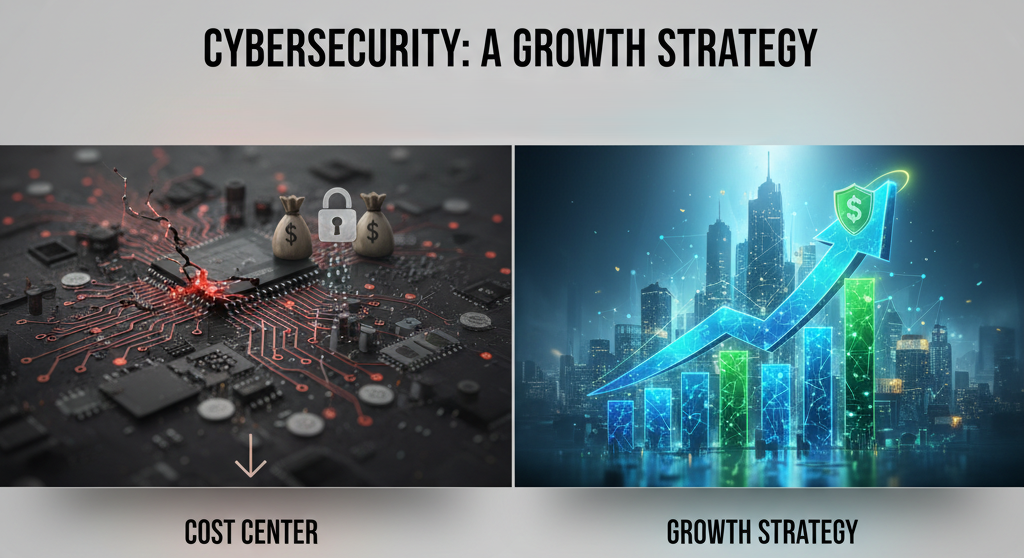You know what’s driving me crazy? 80% of SMBs plan to increase cybersecurity spending, but most business owners still see it as a necessary evil, like paying taxes or getting insurance. Here’s what they’re missing. Strong cybersecurity is now the fastest path to competitive advantage and higher valuations.
Let me tell you something that’ll change how you think about security investments. 77% of M&A experts have recommended one company over another because of the strength of its cybersecurity program. That’s not protection, that’s growth acceleration.
The Competitive Advantage: Using Cybersecurity for Business Growth
So here’s the thing, and this is where it gets really interesting. While your competitors are treating cybersecurity as a grudge purchase, smart business owners are weaponizing it for growth.
Case in Point: Two accounting firms bid on a $500K annual client. Both had identical capabilities and pricing. The winner? The firm that could demonstrate SOC 2 compliance, cyber insurance coverage, and a documented incident response plan. The client told them directly, “We can’t afford to work with someone who might put our data at risk.”

That’s happening every day now. 94% of SMBs consider cybersecurity essential to their business operations, but here’s what most miss: your clients are making security a deal breaker in their vendor selection process, and this is how it should be.
Client Confidence Equals Revenue Growth
55% of consumers would be less likely to continue doing business with a company that has suffered a cyberattack. But flip that around: businesses that can prove their security posture are winning clients from competitors who can’t.
I’m seeing this across every industry:
- Law Firms: Landing bigger clients by demonstrating client privilege protection and confidentiality safeguards
- CPA Practices: Winning tax season clients who demand assurance their financial data is protected, and compliance with FTC\IRS Safeguards
- Medical Practices: Growing patient bases because people want healthcare providers they can trust with sensitive information
- Construction Companies: Securing commercial contracts because general contractors now require cybersecurity certifications from subcontractors
The crazy part? Most SMBs that take cybersecurity seriously can earn customer trust and stand out from competitors.
The Numbers That Matter to Your Bottom Line
Now, the other thing is the actual financial returns. Companies spend 5-20% of their IT budget on cybersecurity, but the ROI is massive when you factor in what strong security actually delivers.
Cyber Insurance Savings (Real Money Back)
Only 17% of small businesses have cyber insurance, and among those that do, premiums vary wildly based on security controls. Here’s what proper security gets you.
- 20-40% lower premiums with MFA, endpoint detection, and security awareness training.
- Additional coverage options that cheaper policies don’t offer
- Faster claims processing because insurers trust businesses with documented security programs
For a 25-person business: Annual savings of $3,000-8,000 in insurance premiums alone. That often covers most of your security investment right there.
Operational Uptime Equals Revenue Protection
50% of SMBs take at least 24 hours to recover from an attack, and 51% experience 8-24 hours of website downtime. But here’s what that really means:
- Lost sales during downtime
- Paying to restore systems
- Losing productivity while employees can’t access systems
- Customer frustration that damages long-term relationships
Average cost of business disruption: $254,445 per incident for SMBs. Investment in prevention: $500-2,500 monthly for comprehensive protection. You do the math.
M&A and Valuation: The Ultimate Cybersecurity Growth Strategy
This is the big one that most business owners never consider. 60% of companies involved in M&A activity consider cybersecurity posture a crucial factor in the due diligence process.
Real Examples:
- Yahoo-Verizon deal: Cybersecurity issues reduced the acquisition price by $350 million
- 86% of M&A experts said a publicly reported breach would detract from the acquisition price
- 49% witnessed M&A deals fall through because of cybersecurity issues discovered during due diligence
But flip the script: 96% of M&A experts noted that cybersecurity readiness factors into valuation calculations. Strong security posture can actually increase your business value when it’s time to sell or seek investment.

The Growth Multiplier Effect
You know what’s interesting? Businesses with mature cybersecurity posture don’t just avoid costs, they accelerate growth in multiple ways:
- Premium Pricing Power: When you can guarantee data protection and demonstrate compliance, you can charge premium rates. Client confidence enables competitive advantage, and competitive advantage supports premium pricing.
- Faster Sales Cycles: 67% of SMBs prioritize affordability in cybersecurity solutions, but smart businesses realize that security shortens sales cycles. When prospects don’t have to worry about vendor risk assessments and security questionnaires, deals close faster.
- Market Expansion Opportunities: Compliance with new regulations enables SMBs to serve larger clients and enter regulated industries. HIPAA compliance opens healthcare markets. SOC 2 compliance opens enterprise markets. PCI DSS compliance enables ecommerce growth.
- Supply Chain Partnership Benefits: Many SMBs work as suppliers or partners to larger companies. Strong cybersecurity doesn’t just protect your business, it protects your partners’ businesses, which makes you a preferred vendor.
The Strategic Investment Framework
So what that means is, cybersecurity spending should be evaluated like any other growth investment. Here’s how smart business owners are thinking about it:
Tier 1 – Foundation (Immediate ROI):
- MFA (Multi-Factor Authentication) and endpoint protection
- Email security
- Network security
- Security awareness training
- Backup and recovery
- Return: Insurance savings, reduced incident response costs, compliance eligibility
Tier 2 – Competitive Advantage (6-12 month ROI):
- Advanced threat protection
- Incident response planning
- Compliance Preparation
- Return: Premium client acquisition, faster sales cycles, higher valuations
Tier 3 – Market Leadership (12-24 month ROI):
- Industry specific compliance
- Advanced security operations
- Continuous security monitoring
- Return: Market expansion, enterprise client access, acquisition premium
The Vision You Need to Adopt
Look, at the end of the day, cybersecurity isn’t about avoiding disaster anymore. It’s about enabling growth that your competitors can’t match.
The businesses winning in 2025 understand this. Security isn’t a cost center, it’s a growth enabler. It’s client confidence. It’s operational resilience. It’s competitive differentiation. And increasingly, it’s business valuation.
While 93% of SMBs are aware of cyber risks, only 11% have adopted AI-powered defenses. The businesses that get ahead of this curve aren’t just protecting themselves, they’re positioning themselves to win market share from competitors who are still treating security as an afterthought.
Think about it this way. Every security control you implement is a capability your competitors probably don’t have. Every compliance certification you earn is a market you can enter that they can’t. Every client you win because of your security posture is revenue they lose.
That’s not just protection. That’s strategy.
Ready to turn cybersecurity into your competitive advantage?
Book a 15 minute Cybersecurity Strategy Call, and we’ll show you exactly how to position security investments for maximum business growth and ROI.
FAQ
Q: How quickly can cybersecurity investments show ROI?
A: The ROI starts immediately, just in different forms. Direct ROI, like cyber insurance premium reductions, can show up in 60-90 days after you implement and document basic controls like MFA and security training. Indirect ROI from cost avoidance, like preventing a $250,000 disruption, is always active. Strategic ROI, like winning a new six-figure client because you have industry compliance, typically hits within 6-12 months.
Q: What’s the minimum security investment for competitive advantage?
A: For most SMBs, a $500-$2,500 monthly investment gets you the foundational “Tier 1” controls. This typically includes advanced endpoint protection, multi-factor authentication, security awareness training, and robust backup/recovery. This package alone is enough to differentiate you from the 50% of competitors who are doing the bare minimum. True market leadership, requires additional investment, but that’s what unlocks enterprise level clients.
Q: How do I prove security value to clients?
A: Don’t wait to be asked. Make it part of your sales and marketing. Get your compliance certifications, and put those logos on your site. Create a simple, one-page “Security & Trust” sheet for your sales team to include in every proposal. It should list your key controls (e.g., “We enforce MFA,” “All data is encrypted,” “We conduct annual employee training”) in plain English. This proactive move builds confidence before they even think to ask.
Q: Can small businesses really compete on cybersecurity?
A: Absolutely. This is the key takeaway. Five years ago, only Fortune 500s could afford this stuff. Today, enterprise grade security tools are available at SMB price points. Your bigger, slower competitors are often stuck with legacy systems. As an SMB, you can be more agile, adopt modern security, and get compliant faster. This isn’t about budget size; it’s about making the strategic decision to lead.
Q: What industries benefit most from cybersecurity positioning?
A: Any business that handles sensitive data sees immediate benefits: healthcare (HIPAA), finance, legal, and accounting. But don’t stop there. Any B2B service provider, like a marketing agency, software developer, or construction subcontractor, can use security as a differentiator. Why? Because you are part of your client’s supply chain, and they are being pushed to secure it. By being the most secure partner, you make their life easier and win the deal.
Sources
- https://www.sba.gov/blog/2024/2024-10/todays-economy-cyber-safety-critical-small-business-success
- https://www.ey.com/en_gl/insights/consulting/how-can-cybersecurity-go-beyond-value-protection-to-value-creation
- https://www.pwc.com/us/en/services/consulting/deals/library/understanding-cyber-due-diligence.html
- https://www.reuters.com/legal/transactional/invisible-threats-why-cybersecurity-due-diligence-is-nonnegotiable-ma-2025-01-24/
- https://www.uschamber.com/co/run/technology/smb-cybersecurity-challenges



